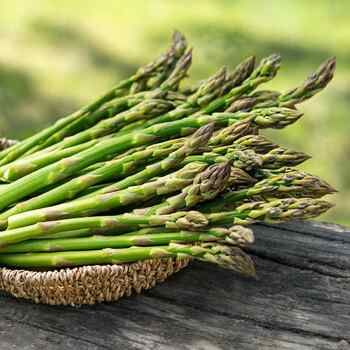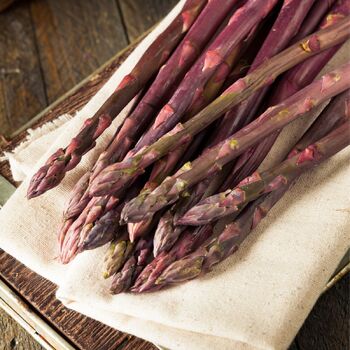
How to Grow Asparagus Crowns
Grow Guide #2650
Family: Asparagaceae
Binomial name: Asparagus officinalis
Life Cycle: Perennial
This 'How to Grow' guide details everything a home gardener needs to know to plant, grow and care for Asparagus (Asparagus officinalis).
When to Plant Asparagus Crowns
Asparagus is a perennial plant that grows year round in most climates. Use the table below to identify the best time of year to plant asparagus crowns in your climate.
| JAN | FEB | MAR | APR | MAY | JUN | JUL | AUG | SEP | OCT | NOV | DEC | |
|---|---|---|---|---|---|---|---|---|---|---|---|---|
| Cool | ||||||||||||
| Temperate | ||||||||||||
| Sub-Tropical | ||||||||||||
| Tropical | ||||||||||||
| Arid |
Preparation
Asparagus are long-lived perennial plants, often producing spears for up to 20 years or more. Plants do not like to be transplanted so choose a position with this in mind. Choose a permanent position where plants can grow undisturbed by regular digging or other disturbance.
Asparagus plants are best grown in full sun. Choose a location that will receive at least 6 hours of full sun each day.
Asparagus plants need a loose, well drained soil enriched with organic matter. Prepare soil by weeding it thoroughly, digging it over to at least a spade’s depth to loosen the soil, and adding aged animal manure or compost. Organic matter can be dug into heavy soil to lighten it so roots can grow freely. Keep the area free of weeds until planting. Learn more about preparing soil for planting here.
How to Plant Asparagus Crowns
Plant asparagus crowns soon after delivery. Store crowns on a wire rack in a dry location until planting. A small amount of mould is normal on untreated crowns; prune any badly affected roots before planting.
- Space crowns 30cm apart.
- Dig a 30cm deep hole and make a mound in the centre.
- Place the crown on the mound and spread the roots out evenly.
- Cover with soil, making sure the centre of the crown is just below the surface.
- Water in well after planting.
- Mulch with straw, sugar cane mulch or similar to suppress weeds until shoots emerge in spring.
How to Grow Asparagus
Asparagus plants may need watering during the growing season. Water when the soil is dry about 5cm below the surface (test this by scratching away a little soil with your finger). Water deeply in the early morning or late afternoon. Avoid watering the leaves of plants to avoid fungal diseases. Learn more about watering here.
If soil was well prepared no extra fertiliser should be necessary. In poor soil or to give your plants an extra boost, application of a balanced fertiliser or one formulated for fruit and vegetables can be beneficial:
- Apply slow release fertiliser at the recommended rate when transplanting or when seedlings are 5-10cm tall.
- Apply liquid fertiliser at the recommended rate and frequency while plants are fruiting or flowering.
For the strongest plants, do not harvest spears in the first year of growth.
When foliage yellows in autumn prune plants to ground level and mulch the area.
How to Harvest Asparagus
Asparagus should be ready to harvest in approximately 390-420 days.
Asparagus spears are ready to harvest when they emerge from the soil and are large enough to eat. Young thin spears are more tender than large thick spears. Harvest spears by cutting them just below the surface of the soil, leaving some to grow and support the plant's growth during summer. Asparagus spears are best eaten soon after harvest. They can be stored short term in a plastic bag in the fridge. For longer term storage, asparagus can be canned, pickled or blanched and then frozen.
Common Problems when Growing Asparagus
Like all plants, asparagus is susceptible to some pests, diseases and other problems. Below is a list of the most common problems gardeners encounter when growing asparagus plants:
%20(1).jpg) Rotten crowns are caused by pathogens entering crowns after sitting in cold, wet soil or being temporarily waterlogged. Crowns may show obvious signs of rot, have no roots or shoots, or produce stunted yellow leaves. Plant crowns in free-draining soil, raised garden beds or containers, and do not water crowns over winter unless soil is very dry.
Rotten crowns are caused by pathogens entering crowns after sitting in cold, wet soil or being temporarily waterlogged. Crowns may show obvious signs of rot, have no roots or shoots, or produce stunted yellow leaves. Plant crowns in free-draining soil, raised garden beds or containers, and do not water crowns over winter unless soil is very dry. Slugs and snails are molluscs that feed on tender leaves and shoots, mostly at night, leaving slimy trails behind them. Control them by removing their hiding places, keeping free range poultry, collecting them by torchlight or by placing traps. Read more about slugs and snails here.
Slugs and snails are molluscs that feed on tender leaves and shoots, mostly at night, leaving slimy trails behind them. Control them by removing their hiding places, keeping free range poultry, collecting them by torchlight or by placing traps. Read more about slugs and snails here. Rust (Puccinia sp.) is a fungal disease that causes brown to orange raised spots or patches to appear on foliage. Fungal spores are spread by wind or water to neighbouring plants, especially in temperatures of 10-20C and when humidity is high. To manage rust, space plants to avoid overcrowding, grow them in the recommended amount of light (eg full sun), do not over fertilise crops, remove dead plants and practice crop rotation. Read more about rust fungus here.
Rust (Puccinia sp.) is a fungal disease that causes brown to orange raised spots or patches to appear on foliage. Fungal spores are spread by wind or water to neighbouring plants, especially in temperatures of 10-20C and when humidity is high. To manage rust, space plants to avoid overcrowding, grow them in the recommended amount of light (eg full sun), do not over fertilise crops, remove dead plants and practice crop rotation. Read more about rust fungus here. Aphids are small (2-4mm long) sap-sucking insects that congregate on the new shoots or the undersides of leaves. They can cause leaves to wilt or become discoloured, and also excrete honeydew which can attract ants and other insect pests. To manage aphids, remove them by spraying with a garden hose, apply a soap or alcohol spray, or encourage predatory insects to your garden. Read more about aphids here.
Aphids are small (2-4mm long) sap-sucking insects that congregate on the new shoots or the undersides of leaves. They can cause leaves to wilt or become discoloured, and also excrete honeydew which can attract ants and other insect pests. To manage aphids, remove them by spraying with a garden hose, apply a soap or alcohol spray, or encourage predatory insects to your garden. Read more about aphids here.


.png)




